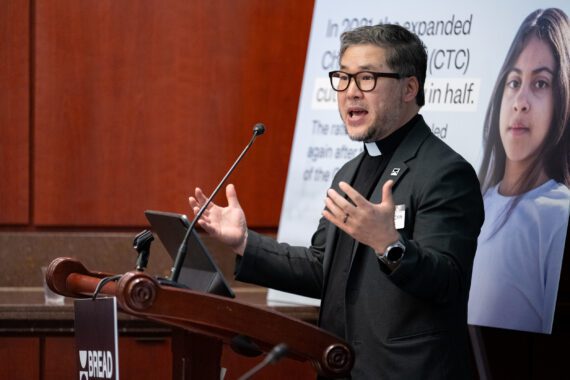This is the third in a series that explores how anti-hunger advocates can help advance gender pay equity as an essential element of ending hunger. Read the first and second parts.
Racial and gender pay inequities are an integral part of the U.S. economy. Just over 60 years ago, Congress prohibited pay discrimination based on gender by enacting the Equal Pay Act of 1963. Since then, there has been slow progress toward closing the pay gap. In 2022 (latest data available), women who worked full-time, year-round were paid 84 cents for every $1 paid to men.
The United States needs to speed up progress as part of its efforts to end hunger. At the rate of progress toward pay equity over the past two decades (2000-2022), the United States will not close the gender pay gap until 2067. Racial and gender pay inequities contribute to the fact that single mothers and their children have the highest poverty rates in the country.
A poverty-level income is not enough for a family to pay essential bills. In 2021, for example, the poverty line for an adult and two children was just shy of $22,000 a year. The fact that so many single mothers and their children have even less is shocking—and unnecessary in a wealthy country.
The nationwide poverty rate among single mothers and their children was 31.3 percent. It was higher among families of color: 35.9 percent of Latina families, 37.4 percent of Black families, and 42.6 percent of Native American families lived on $22,000 or less that year. Meanwhile, the poverty rate among all U.S. households was 11.6 percent.
In March 2024, the Center for American Progress published its Playbook for the Advancement of Women in the Economy. One of the 13 chapters focuses on shrinking the gender wage gap.
The Playbook’s recommendations support and echo those of Bread for the World in its longtime advocacy work on gender equity as essential to ending hunger. For example, one of the key barriers to gender equity identified in Bread’s 2015 Hunger Report, When Women Flourish … We Can End Hunger, is unpaid work responsibilities.
The fact that women still carry out disproportionate shares of child care, elder care, and household chores means that they have fewer hours available to work for pay. This is also true in reverse: the adult family member whose job pays less will cost the family less money if she or he assumes unpaid caregiving tasks. In the absence of available and affordable alternatives, women are more likely to work fewer hours or drop out of the labor force to take on caregiving responsibilities.
Consensus on the way forward may be helpful in theory, but the Playbook’s recommendations show that not enough has changed since When Women Flourish… was published. They will help solve current problems that were described in Bread’s report back in 2015 as well.
These policy solutions include:
- Invest in the care economy, including paid family and medical leave and sustained public investments in child care and elder care. Three other chapters in the Playbook discuss the benefits of these changes for women’s participation in the economy and for the economy overall.
- Pass the Paycheck Fairness Act, which would strengthen the equal pay protections of the 1963 Equal Pay Act and add other protections, such as prohibiting retaliation against workers who challenge pay discrimination.
- Increase the minimum wage and eliminate the tipped minimum wage—for example by passing the Raise the Wage Act and emulating the many states that have enacted minimum wages higher than the federal minimum wage, which has been $7.25 an hour since 2009.
- Enact salary range transparency laws: more states are now passing such laws to “help level the playing field in negotiations and reduce gender gaps in hiring wages….”
- Enact salary history bans, because “relying on the use of prior salary history perpetuates and exacerbates the gender wage gap.”
Increasing the wages of women and closing the gender wage gap will help create economic security and stability for women and their families, providing economywide benefits as women can spend, save, or invest more and are more likely to remain in paid employment.
Women’s wages are not just critical for them and their families but also for U.S. economic growth. Higher wages boost spending and investment, two of the fundamental drivers of economic growth.
Churches, faith-based organizations, and civil society organizations such as charities, bar associations, labor unions, or environmental rights activists can advance food security and help end hunger by making the connections between these goals and gender equity. It is the just and right thing to do.
Michele Learner is managing editor, Policy and Research Institute, with Bread for the World.



